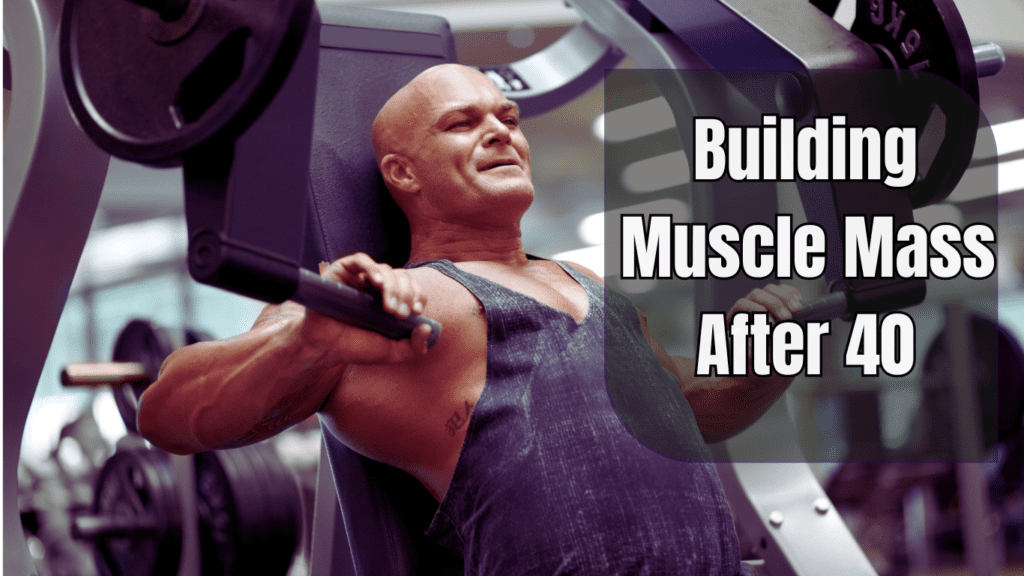Embracing Strength: The Importance of Building Muscle Mass After 40
In this article, we will explore essential strategies for building muscle mass after 40, providing expert tips and real-life success stories to guide your journey.
Imagine the frustration of realizing that the strength you once took for granted has begun to slip away. For many over the age of 40, this is a common experience. Studies reveal that after the age of 40, people can lose up to 8% of their muscle mass per decade, a condition known as sarcopenia. This gradual loss of muscle mass and strength can impact everything from daily activities to overall health. But here’s an empowering truth: “Age is no barrier. It’s a limitation you put on your mind.” This mindset shift can be the key to unlocking your potential and revitalizing your fitness journey.

Building muscle mass after 40 is not just about enhancing your appearance; it’s crucial for maintaining a healthy, active lifestyle. As we age, muscle mass naturally declines, but the implications go far beyond just looking different. Maintaining and building muscle mass offers significant benefits, including a more efficient metabolism, improved bone density, and enhanced overall health. Strong muscles support better balance, reduce the risk of falls and injuries, and make everyday activities easier and more enjoyable. Embracing muscle-building strategies can help you stay vibrant and energetic, making the effort to build muscle mass after 40 not only valuable but essential.
The importance of focusing on building muscle mass after 40 cannot be overstated. As we age, our bodies undergo a variety of changes that can impact our physical health. Hormonal shifts, such as decreased levels of testosterone and growth hormone, combined with a natural decline in physical activity, contribute to muscle loss. Additionally, the body’s ability to repair and build muscle slows down, making it necessary to approach fitness with a strategic mindset. These changes, however, do not mean that building muscle mass after 40 is impossible. Rather, they highlight the need for tailored approaches that address these age-related factors.
The Role of Nutrition
Proper nutrition plays a pivotal role in building muscle mass at any age, but its importance becomes even more pronounced as you get older. Protein is the fundamental building block for muscle repair and growth. For individuals over 40, consuming sufficient protein is essential to counteract the natural decline in muscle mass. Incorporating high-quality protein sources into your diet, such as lean meats, fish, eggs, dairy products, and plant-based proteins, can help you meet your muscle-building needs. Additionally, maintaining an appropriate caloric intake is crucial. While it might be tempting to reduce calories to manage weight, insufficient calories can hinder muscle growth and recovery. Balancing your caloric intake ensures that your body has the energy it needs to build and maintain muscle.
Hydration also plays a critical role in muscle health. Proper hydration supports optimal muscle function and helps prevent cramps and fatigue. Drinking enough water throughout the day, especially before, during, and after exercise, is essential for maintaining peak performance and promoting muscle recovery.
Subscribe And Get Our Free E-Book:Unlocking The Power Of Nutrition-Supplements, Substitutes, and Superfoods!
The Role of Exercise
Exercise, particularly strength training, is key to building muscle mass after 40. Resistance training exercises, such as weight lifting, bodyweight exercises, and resistance band workouts, stimulate muscle growth and increase strength. These exercises help counteract muscle loss by promoting muscle protein synthesis and enhancing muscle fiber recruitment. Regular strength training can lead to significant improvements in muscle mass, strength, and overall physical function.
Incorporating a variety of exercises into your routine can also provide additional benefits. Compound movements, such as squats, deadlifts, and bench presses, engage multiple muscle groups and provide a comprehensive workout. Additionally, integrating cardiovascular exercise can improve cardiovascular health, support weight management, and enhance overall fitness levels.
Flexibility and Recovery
In addition to strength training, focusing on flexibility and recovery is essential for maintaining muscle health as you age. Flexibility exercises, such as stretching and yoga, improve range of motion and reduce the risk of injury. Incorporating flexibility routines into your weekly schedule can help you stay agile and prevent stiffness.
Recovery is equally important. As we age, our bodies may require more time to recover from intense physical activity. Allowing adequate time for rest and recovery helps prevent overtraining and supports muscle repair and growth. Prioritizing sleep is another crucial aspect of recovery. Quality sleep supports muscle repair and overall health, making it an essential component of any fitness regimen.
Setting Realistic Goals
Setting realistic goals is an important step in building muscle mass after 40. Establishing clear, achievable goals helps you stay motivated and track your progress. Whether your goal is to increase strength, improve muscle tone, or enhance overall fitness, having specific objectives allows you to create a focused and effective fitness plan. Regularly assessing your progress and adjusting your goals as needed ensures that you stay on track and continue making improvements.
Building muscle mass after 40 is a rewarding and achievable goal that can significantly enhance your quality of life. By understanding the challenges, embracing effective nutrition and exercise strategies, and focusing on flexibility and recovery, you can successfully build and maintain muscle mass well into your later years. This article aims to provide you with the practical tips, scientific insights, and real-world applications you need to achieve your fitness goals. Whether you’re just starting your fitness journey or looking to optimize your routine, the information here will help you take control of your health and build a stronger, healthier body.
8 Things Nobody Tells You About Gaining Muscle After 40
Understanding Muscle Mass After 40: Physiological Changes, Metabolism, and Myths
Building muscle mass after 40 requires a deeper understanding of the physiological changes that occur with aging. One significant change is sarcopenia, the gradual loss of muscle mass and strength that typically begins in middle age. Sarcopenia is not just a matter of losing muscle size; it also involves a decline in muscle quality, which affects strength and physical function. Research suggests that sarcopenia can start as early as the mid-30s and accelerates with age, making it crucial to address this issue proactively.

Sarcopenia affects muscle fibers, leading to a decrease in both the size and number of muscle fibers. This process is linked to various factors, including hormonal changes, reduced physical activity, and altered muscle protein synthesis. Sarcopenia can impact your ability to perform everyday tasks and lead to increased frailty, making it essential to implement strategies that combat muscle loss.
Hormonal Changes
Another critical aspect of building muscle mass after 40 involves understanding the hormonal changes that occur with age. Two key hormones influencing muscle mass are testosterone and growth hormone.
Testosterone is vital for muscle development and maintenance. For men, testosterone levels typically begin to decline around the age of 30 and continue to decrease gradually. This decline can contribute to reduced muscle mass and strength. Women also experience a significant drop in testosterone levels around menopause, which can further impact their ability to build and maintain muscle.
Similarly, growth hormone plays an essential role in muscle growth and repair. Its levels decrease with age, affecting the body’s ability to build and maintain muscle mass. Growth hormone is crucial for muscle protein synthesis, which helps repair and build muscle tissue. A decrease in growth hormone levels can make it more challenging to build muscle, highlighting the importance of tailored exercise and nutrition strategies.
Impact on Metabolism and Overall Health
The loss of muscle mass with age has a profound impact on metabolism and overall health. Muscle tissue is metabolically active, meaning it requires more energy to maintain compared to fat tissue. As muscle mass decreases, the metabolic rate slows down, which can lead to weight gain and difficulty in managing body weight. This decreased metabolism can make it harder to maintain a healthy weight and can contribute to the accumulation of excess body fat.
Energy levels are also affected by muscle loss. Muscle strength and endurance are crucial for maintaining vitality and performing daily activities. Reduced muscle mass can lead to increased fatigue and decreased physical stamina, making everyday tasks more challenging and impacting overall quality of life.
Moreover, muscle mass plays a significant role in preventing chronic diseases. Adequate muscle mass helps regulate blood sugar levels, supports cardiovascular health, and reduces the risk of conditions such as obesity and type 2 diabetes. Strong muscles contribute to better insulin sensitivity and can help manage or prevent various health issues associated with aging.
Myths vs. Reality
When it comes to building muscle mass after 40, several myths and misconceptions can create confusion and set unrealistic expectations. One prevalent myth is that it’s too late to start building muscle after 40. In reality, while it may be more challenging to build muscle with age, it is entirely possible with the right approach. Age-related changes in muscle mass can be managed and even reversed through consistent strength training and proper nutrition.
Another common myth is that older adults should avoid lifting heavy weights to prevent injury. On the contrary, strength training with appropriate weights is highly beneficial for older adults. The key is to focus on proper form, start with manageable weights, and gradually increase intensity. Strength training not only helps in building muscle but also improves bone density and overall functional fitness.
Some people believe that a high-protein diet is harmful or unnecessary for older adults. However, protein is a crucial component for muscle repair and growth, regardless of age. Ensuring adequate protein intake supports muscle maintenance and helps counteract age-related muscle loss.
A final myth is that muscle loss with age is inevitable and cannot be slowed or reversed. While sarcopenia is a natural part of aging, its progression can be significantly slowed with the right interventions. Regular resistance exercise, a balanced diet rich in protein, and a healthy lifestyle can effectively combat the effects of aging on muscle mass.
Understanding these aspects of building muscle mass after 40 helps in developing a practical approach to fitness and health. By addressing physiological changes, hormonal shifts, and the impact on metabolism, you can create an effective strategy to maintain and build muscle mass, improve overall health, and enhance your quality of life.
Impact of Aging on Muscle Mass, Metabolic Rate, and Physical Strength (Ages 40-70)Chart:

The Science of Muscle Building: Understanding Muscle Hypertrophy, Nutrition, and Recovery
When it comes to building muscle mass after 40, understanding the science behind muscle hypertrophy is crucial. Muscle hypertrophy refers to the increase in muscle size and strength that occurs as a response to resistance training. This process involves a series of physiological changes that enhance muscle growth, and while the basic principles remain the same, how these principles apply can change with age.

Muscle Hypertrophy
Muscle hypertrophy occurs in two primary ways: myofibrillar hypertrophy and sarcoplasmic hypertrophy. Myofibrillar hypertrophy increases the size of muscle fibers by adding more contractile proteins, which enhances strength. Sarcoplasmic hypertrophy, on the other hand, involves an increase in the volume of the muscle cell’s cytoplasm, improving endurance and energy storage. Both types of hypertrophy contribute to muscle growth, but the emphasis may shift as you age.
As you age, the efficiency of muscle hypertrophy can decrease due to changes in hormonal levels, reduced muscle protein synthesis, and slower recovery rates. However, building muscle mass after 40 is still achievable with the right approach. Progressive overload is a key principle here. Progressive overload involves gradually increasing the resistance or intensity of your workouts to continually challenge your muscles and stimulate growth. As you age, it becomes even more important to implement progressive overload effectively, as your muscles may respond differently than they did in your younger years.
Importance of Progressive Overload and Muscle Repair
Progressive overload is essential for continued muscle growth and adaptation. Without it, your muscles may not experience the necessary stimulus to grow and strengthen. To apply progressive overload, you can increase the weight you lift, the number of repetitions or sets, or the intensity of your workouts.
Muscle repair is another critical aspect of hypertrophy. During resistance training, small tears occur in muscle fibers. These tears are repaired during rest, leading to muscle growth. Proper nutrition and recovery are vital to support this repair process. Without adequate repair time and nutrients, muscle growth can be impeded, making it essential to focus on both workout intensity and recovery.
Nutrition for Muscle Growth
Proper nutrition plays a significant role in building muscle mass after 40. The macronutrient breakdown is crucial for supporting muscle growth:
- Protein: Protein is the most important macronutrient for muscle repair and growth. It provides the building blocks needed for muscle tissue repair and synthesis. Aim to include high-quality protein sources such as lean meats, fish, eggs, dairy products, and plant-based proteins in your diet. Timing is also important; consuming protein shortly after workouts can help kickstart the muscle repair process. Foods rich in leucine, an amino acid critical for muscle protein synthesis, are particularly beneficial. Leucine-rich foods include eggs, chicken, and whey protein.
- Carbohydrates: Carbohydrates provide the energy necessary for intense workouts and recovery. Consuming complex carbohydrates like whole grains, fruits, and vegetables can help sustain energy levels and replenish glycogen stores depleted during exercise. Proper carbohydrate intake supports overall performance and aids in muscle recovery.
- Fats: Healthy fats, such as those found in avocados, nuts, seeds, and olive oil, are essential for hormone production and overall health. Including fats in your diet can support optimal hormone levels, which are crucial for muscle growth and maintenance.
Role of Hydration and Micronutrients
Hydration is another crucial factor in building muscle mass after 40. Staying well-hydrated helps maintain muscle function and prevent cramps and fatigue. Aim to drink plenty of water throughout the day, and consider consuming electrolyte-rich beverages if you engage in intense workouts.
Micronutrients, including vitamins and minerals, also play a role in muscle health and recovery. Nutrients such as vitamin D, calcium, magnesium, and zinc support muscle function and repair. Ensuring a well-balanced diet rich in fruits, vegetables, and whole foods can help you meet your micronutrient needs and support overall muscle health.
Recovery and Rest
Recovery is a critical component of muscle building, especially as you age. Proper rest and recovery allow your muscles to repair and grow stronger. Quality sleep is vital for muscle recovery, as it is during sleep that the body releases growth hormone and performs essential repair processes. Aim for 7-9 hours of sleep each night to support optimal muscle growth and overall health.
Rest days are also essential. Incorporating rest days into your training regimen allows your muscles to recover and reduces the risk of overtraining. Active recovery, such as light exercise or stretching, can help promote circulation and reduce muscle stiffness without placing additional strain on your body.
To enhance recovery, consider incorporating stretching, massage, and active recovery techniques. Stretching can improve flexibility and reduce muscle tension, while massage can help alleviate soreness and improve blood flow. Active recovery involves low-intensity activities that help maintain blood circulation and prevent stiffness, such as walking, swimming, or gentle yoga.
Building muscle mass after 40 involves understanding the science of muscle hypertrophy, ensuring proper nutrition, and prioritizing recovery. By focusing on progressive overload, maintaining a balanced diet, staying hydrated, and allowing adequate rest, you can effectively build and maintain muscle mass, supporting overall health and fitness as you age.
Practical Strategies: Strength Training, Progressive Overload, and Flexibility
Building muscle mass after 40 requires a thoughtful and strategic approach to strength training, progressive overload, and flexibility. As we age, our bodies undergo changes that affect muscle growth and recovery, making it essential to adapt our fitness strategies accordingly. Here’s how you can effectively enhance muscle growth while considering the unique needs of individuals over 40.
Strength Training Regimen
A well-structured strength training regimen is crucial for building muscle mass after 40. Tailoring your workouts to your fitness level and addressing age-related changes can optimize results and minimize the risk of injury. Here’s how to approach strength training based on experience level:

For beginners, the focus should be on developing a solid foundation with low-impact exercises. A beginner’s routine may include:
- Full-body workouts 2-3 times per week, allowing for sufficient recovery between sessions.
- Bodyweight exercises such as squats, lunges, push-ups, and planks to build strength without excessive strain.
- Light to moderate weights for exercises like dumbbell curls, shoulder presses, and rows, focusing on proper form and technique.
Intermediate exercisers can benefit from increased intensity and variety. Consider the following:
- Split routines that target different muscle groups on separate days (e.g., upper body one day, lower body the next) to allow for better recovery and focused training.
- Moderate to heavy weights for compound movements such as barbell squats, deadlifts, and bench presses, while paying attention to joint health.
- Increased volume through additional sets and reps, ensuring proper warm-up and cooldown routines to prevent injuries.
For those at an advanced level, it’s important to challenge your muscles with complex and intense workouts. An advanced routine might include:
- Advanced split routines or push/pull/legs splits to maximize muscle engagement and recovery.
- Heavy weights and advanced techniques such as supersets, drop sets, or rest-pause sets to push your muscles beyond their comfort zone.
- Focus on proper recovery to prevent overtraining and injury, emphasizing the importance of rest days and active recovery.
Importance of Compound Exercises
Compound exercises are particularly beneficial for building muscle mass after 40. These exercises engage multiple muscle groups simultaneously, offering a more efficient workout and better muscle engagement. Key compound exercises include:
- Squats: Targeting the quadriceps, hamstrings, glutes, and lower back, squats are essential for lower-body strength and functional movement.
- Deadlifts: A full-body exercise that strengthens the hamstrings, glutes, lower back, and core, promoting overall strength and stability.
- Bench Press: Working the chest, shoulders, and triceps, the bench press is crucial for upper-body strength.
Incorporating these exercises helps in building muscle mass effectively while ensuring balanced development across major muscle groups. It’s also important to balance weight training with cardio to support cardiovascular health and manage body weight. Include cardio sessions 2-3 times per week, such as brisk walking, swimming, or cycling, to complement your strength training.
Progressive Overload Techniques
To effectively build muscle mass after 40, employing progressive overload is essential. This principle involves gradually increasing the intensity of your workouts to continually challenge your muscles. Techniques for progressive overload include:
- Increasing Weights: Gradually add more weight to your exercises to keep challenging your muscles and stimulate growth.
- Increasing Repetitions: Add more reps to your sets to enhance endurance and muscle growth.
- Increasing Sets: Perform additional sets to increase the total volume of your workout.
Regularly tracking your progress is vital to ensure continued improvement. Use a workout journal or app to record weights, reps, and sets, and review your progress periodically. Adjust your routines based on your observations to keep advancing and avoid plateaus.
Flexibility and Mobility
Incorporating flexibility and mobility exercises is crucial for maintaining overall health and preventing injuries, especially as you age. Prioritize the following:
- Flexibility Exercises: Include activities such as yoga and dynamic stretching to improve your range of motion and reduce muscle stiffness. Yoga can enhance flexibility, balance, and core strength, while dynamic stretching helps prepare your muscles for exercise by increasing blood flow and mobility.
- Joint Health: Focus on exercises that maintain and improve joint function, such as gentle stretching and mobility drills. This approach helps prevent stiffness and reduces the risk of injuries.
Maintaining flexibility and mobility supports not only muscle health but also overall functional fitness, helping you perform daily activities with ease.
By integrating these practical strategies into your routine, you can effectively address the unique challenges of building muscle mass after 40. Tailoring your strength training, applying progressive overload, and focusing on flexibility and mobility will enhance muscle growth, improve overall fitness, and contribute to a healthier, more active lifestyle.
Addressing Common Challenges: Time Management, Injury Prevention, and Staying Motivated
Building muscle mass after 40 comes with its set of unique challenges. Addressing these effectively involves managing your time, preventing injuries, and staying motivated. Let’s explore practical strategies to help you overcome these hurdles and achieve your fitness goals.

Time Management
Fitting workouts into a busy schedule can be one of the biggest challenges when building muscle mass after 40. Life’s demands often make it difficult to stick to a regular exercise routine. Here are some tips for managing your time effectively:
- Prioritize Workouts: Treat your workouts as essential appointments. Schedule them into your calendar just as you would any important meeting or event. Consistency is key, and making exercise a priority helps ensure it becomes a regular part of your routine.
- Efficient Workout Strategies: Utilize high-intensity interval training (HIIT) and circuit training to maximize the effectiveness of your workouts in a shorter amount of time. HIIT involves short bursts of intense exercise followed by brief rest periods, which can improve cardiovascular fitness and muscle strength in less time. Circuit training involves performing a series of exercises with minimal rest in between, providing a full-body workout that’s both time-efficient and effective.
- Incorporate Short Workouts: Even brief, focused workouts can be highly beneficial. If you can’t fit in a full session, try shorter workouts of 20-30 minutes. High-intensity exercises can still provide significant benefits without requiring a lengthy commitment.
Injury Prevention and Management
As we age, the risk of injury increases, making injury prevention and management crucial when building muscle mass after 40. Here’s how to address common injuries and maintain joint and tendon health:
- Common Injuries: Older adults are more prone to injuries such as strains, sprains, and joint issues. These injuries often result from overuse, improper technique, or insufficient warm-up. To prevent injuries, ensure you perform a proper warm-up before starting your workout and cool down afterward. Incorporating mobility exercises and stretching into your routine can also help maintain flexibility and prevent stiffness.
- Strategies for Joint and Tendon Health: Focus on maintaining joint health by incorporating low-impact exercises that reduce stress on your joints, such as swimming or cycling. Strengthening the muscles around your joints can also provide added support and reduce the risk of injury. Additionally, using proper technique and gradually increasing weights can help prevent strain on tendons and ligaments.
- Listen to Your Body: Pay attention to any signs of discomfort or pain. If you experience any unusual symptoms, it’s essential to address them promptly. Consult with a healthcare professional if needed, and consider modifying your routine to accommodate any limitations or injuries.
Staying Motivated
Maintaining motivation is a key component of building muscle mass after 40. Finding ways to stay engaged and committed to your fitness goals can make a significant difference in your success. Here’s how to stay motivated:
- Set Realistic Goals: Establish clear, achievable goals that align with your fitness level and desired outcomes. Break these goals into smaller milestones to track your progress and celebrate your achievements along the way. Setting realistic goals helps keep you focused and provides a sense of accomplishment as you reach each milestone.
- Track Progress: Regularly monitor your progress to see how far you’ve come. Use a workout journal or app to log your workouts, track improvements in strength, and note any changes in muscle mass. Seeing tangible evidence of your progress can boost motivation and provide a sense of satisfaction.
- Find a Support System: Having a support system can make a significant difference in staying motivated. Whether it’s a workout partner, a fitness group, or an online community, surrounding yourself with others who share your goals can provide encouragement, accountability, and a sense of camaraderie.
- Stay Flexible: Understand that motivation can fluctuate. It’s normal to have periods of high and low motivation. During low periods, remind yourself of your goals and the benefits of staying active. Adjust your routine if necessary to keep things fresh and engaging.
By addressing these common challenges, you can effectively support your efforts in building muscle mass after 40. Managing your time wisely, focusing on injury prevention, and staying motivated will help you overcome obstacles and achieve your fitness goals. With a strategic approach and commitment, you can successfully enhance muscle growth, improve overall fitness, and maintain a healthy lifestyle as you age.
Chart: Enhancing Muscle Mass After 40
| Aspect | Beginner | Intermediate | Advanced |
|---|---|---|---|
| Workout Frequency | Full-body workouts 2-3 times per week | Split routines 3-4 times per week | Advanced split routines 4-6 times per week |
| Exercise Type | Bodyweight exercises, light weights | Moderate to heavy weights, compound movements | Heavy weights, advanced techniques (supersets, etc.) |
| Focus | Building foundation, proper form | Increased volume, joint health | Intensity, complex movements |
| Compound Exercises | Squats, push-ups, lunges | Squats, deadlifts, bench press | Squats, deadlifts, bench press, advanced variations |
| Progressive Overload | Increase reps, add weight gradually | Increase sets and intensity | Heavy weights, advanced techniques |
| Flexibility and Mobility | Basic stretching and yoga | Dynamic stretching, mobility drills | Advanced flexibility training, yoga |
| Time Management | Schedule workouts as appointments | High-intensity interval training (HIIT), circuit training | Short, intense sessions, efficient use of time |
| Injury Prevention | Proper warm-up, gentle exercises | Focus on joint health, gradual progression | Use proper technique, listen to body |
| Motivation | Set realistic goals, track progress | Find a support system, set milestones | Celebrate achievements, adjust routine as needed |
Additional Insights and Tips
- Benefits of Compound Exercises: Incorporating compound exercises like squats, deadlifts, and bench presses offers a more efficient workout, engaging multiple muscle groups simultaneously. This not only builds muscle more effectively but also enhances overall functional strength.
- Tracking Progress: Regularly track your workouts using a journal or app to monitor weights, reps, and overall progress. This helps in adjusting routines and overcoming plateaus.
- Flexibility and Mobility: Emphasize flexibility and mobility exercises to support joint health and prevent injuries. Yoga and dynamic stretching can greatly improve range of motion and muscle recovery.
- Time-Efficient Strategies: Utilize techniques such as HIIT and circuit training to maximize the benefits of shorter workouts. This approach is especially useful for those with busy schedules.
- Expert Advice: According to fitness trainer Mark Anderson, focus on understanding how your body changes with age and adapting your approach. Nutritionist Jessica Lee stresses the importance of a protein-rich diet, while Dr. David Wong highlights integrating exercise into a comprehensive health plan.
Anton’s Journey to Health and Fitness and Some Expert Insights
Building muscle mass after 40 can be a life-changing journey, as exemplified by the inspiring story of Anton, a 43-year-old man who faced significant health challenges before discovering the transformative power of fitness.
Three years ago, Anton found himself at a crossroads. At 43, he was struggling with multiple health issues: he had a noticeable belly, suffered from depression, and was managing high blood pressure. His physical condition was affecting his self-esteem and overall quality of life. The weight of his health problems made every day feel like a burden. Anton knew he needed a change but felt overwhelmed by where to start.
Initially, Anton’s attempts to improve his health were met with frustration. He faced several challenges, including a lack of motivation and an unclear direction on how to start his fitness journey. The first few weeks were particularly tough. The workouts felt arduous, and Anton was disheartened by the slow progress. His muscles ached, and he struggled to stick to a consistent routine. The journey was demanding, and the initial results were not immediately apparent, which tested his resolve.
Despite these early struggles, Anton persevered. He decided to approach building muscle mass after 40 as a long-term commitment rather than a quick fix. He began by setting realistic goals and focusing on gradual progress. Anton started with simple bodyweight exercises and slowly incorporated weights into his routine. His workouts were initially short and manageable, focusing on core strength and endurance.
The turning point in Anton’s journey came when he began to see small, yet meaningful improvements. His energy levels increased, and he started noticing changes in his physique. The initial signs of progress provided the motivation he needed to continue. Anton began enjoying the process of working out. He discovered a newfound appreciation for the discipline and focus required to achieve his goals.
Building muscle mass after 40 not only helped Anton transform his physical appearance but also had a profound impact on his mental health. As his fitness improved, so did his mood. Regular exercise became a powerful tool for managing his depression. The endorphins released during workouts elevated his spirits and contributed to a more positive outlook on life. Anton also benefited from improved self-esteem. As he shed pounds and built muscle, his self-image transformed from one of self-doubt to confidence and pride.
Nutrition played a crucial role in Anton’s transformation. He consulted with a nutritionist to develop a diet plan that complemented his fitness routine. A balanced diet rich in protein, healthy fats, and complex carbohydrates supported his muscle growth and overall health. Anton focused on incorporating nutrient-dense foods and maintained proper hydration to fuel his workouts and recovery.
Over time, Anton’s efforts paid off significantly. After three years of dedication, he had not only built impressive muscle mass but also resolved his high blood pressure issues. His physician noted a remarkable improvement in his cardiovascular health. Anton’s journey was a testament to the fact that building muscle mass after 40 could lead to substantial improvements in both physical and mental well-being. He no longer experienced the discomfort of high blood pressure, and his overall health was markedly better.
Today, Anton continues to thrive in his fitness journey. His story highlights the transformative power of consistent effort and dedication. He enjoys an active lifestyle, feels great, and has embraced fitness as an integral part of his life. Anton’s success underscores the importance of patience, perseverance, and a holistic approach to health and wellness.
Quotes and Tips from Experts
To provide further insight into building muscle mass after 40, here are some valuable tips and quotes from fitness trainers, nutritionists, and healthcare professionals:
Fitness Trainer’s Insight
“Building muscle mass after 40 isn’t just about lifting weights; it’s about understanding how your body changes with age and adapting your approach accordingly. Focus on progressive overload, incorporate compound exercises, and always prioritize proper form to reduce the risk of injury. Consistency and patience are key.” — Mark Anderson, Certified Personal Trainer
Nutritionist’s Advice
“Nutrition plays a vital role in muscle growth and overall health, especially as we age. Ensure your diet includes sufficient protein to support muscle repair and growth. Leucine-rich foods, like eggs and lean meats, are particularly effective. Don’t overlook the importance of hydration and micronutrients, as they support overall bodily functions and recovery.” — Jessica Lee, Registered Dietitian Nutritionist
Healthcare Professional’s Perspective
“Regular physical activity, including strength training, can have significant health benefits for individuals over 40. It’s crucial to integrate exercise into a comprehensive health plan that includes managing stress, maintaining a balanced diet, and getting adequate sleep. Regular check-ups with your healthcare provider can help monitor progress and address any health concerns.” — Dr. David Wong, Cardiologist
Additional Tips
- Set Realistic Goals: Start with achievable goals that match your current fitness level. Gradually increase the intensity and complexity of your workouts as you progress.
- Listen to Your Body: Pay attention to how your body responds to different exercises and adjust accordingly. Rest and recovery are as important as the workouts themselves.
- Stay Consistent: Consistency is critical for long-term success. Even on days when motivation is low, maintaining a routine helps ensure continued progress.
- Seek Professional Guidance: Consulting with a fitness professional or healthcare provider can provide personalized advice and support, making your fitness journey more effective and safer.
Anton’s success story, combined with expert insights, illustrates that building muscle mass after 40 is not only achievable but also transformative. By embracing a structured approach to fitness and nutrition, you too can experience the profound benefits of a healthier, stronger, and more confident self.
Wrapping Up: Embracing the Journey of Building Muscle Mass After 40
As we conclude our exploration into building muscle mass after 40, let’s take a moment to reflect on the journey you’re about to embark on. This is not just about lifting weights or changing your diet; it’s about embracing a lifestyle that fosters strength, health, and confidence at any age.

Building muscle mass after 40 is not just a possibility—it’s a powerful reality waiting to be realized. Throughout this journey, you’ve learned about the physiological changes that come with age and how to adapt your workouts, nutrition, and overall approach to fit these new realities. It’s about understanding the science behind muscle growth and applying practical strategies to achieve lasting results.
Remember, the key to building muscle mass after 40 is consistency. It’s about setting realistic goals, tracking your progress, and celebrating each milestone along the way. Your journey will involve overcoming challenges, but each step forward is a testament to your commitment and resilience.
Embrace the Process
The path to building muscle mass after 40 is filled with opportunities for growth. Embrace each challenge as a stepping stone to a healthier and stronger you. As you build muscle, you’re not only improving your physique but also enhancing your overall well-being. The journey may be demanding at times, but the rewards are profound—improved health, better self-esteem, and a more active, fulfilling life.
Motivational Message
Now is the time to take action. Believe in your ability to transform your life through fitness. It’s never too late to start, and every effort you make brings you closer to a stronger, healthier self. Remember, you’re not alone on this journey. Countless individuals are discovering the benefits of building muscle mass after 40 and transforming their lives in the process. Your commitment to this journey can lead to incredible results, and you have the power to achieve them.
Share Your Journey
We invite you to share your experiences or questions about building muscle mass after 40. Your stories can inspire others and provide valuable insights. Whether you’ve just started your fitness journey or have been working on it for a while, your experiences are valuable. Engaging with a community of like-minded individuals can offer support and encouragement.
Further Reading and Resources
For those eager to delve deeper into the subject, several resources can provide additional knowledge and inspiration:
- Books:
- “Strong & Lean: 9-Minute Workouts for Women” by Laura Williams – A great resource for quick, effective workouts.
- “Fitness Over 40: Your Guide to a Healthier, Stronger, and More Vital Life” by Dr. Judith S. Beck – Offers insights specifically for individuals over 40.
- Articles:
- “How to Build Muscle After 40: Tips and Techniques for Success” – Find this article in reputable fitness magazines or online journals.
- “The Science of Aging and Muscle Growth” – Look for articles in scientific publications or trusted health websites.
- Scientific Papers:
- “Sarcopenia and Muscle Growth in Older Adults” – Review research papers available through academic databases.
- “The Impact of Resistance Training on Aging Muscles” – Explore studies that offer evidence-based insights into muscle building.
Useful Tools
To support your journey, consider using these tools:
- Apps for Tracking Workouts and Nutrition:
- MyFitnessPal: Track your nutrition and workouts to stay on top of your goals.
- Fitbod: Provides personalized workout plans and tracks your progress.
- Websites or Communities for Support and Motivation:
- Reddit Fitness: Engage with a community of fitness enthusiasts for advice and motivation.
- MyFitnessPal Community: Connect with others who are on similar fitness journeys and share your progress.
In closing, building muscle mass after 40 is an empowering endeavor that can redefine your health and well-being. Approach each day with determination and patience, and you will see the results of your hard work. The journey to a stronger, healthier you is within reach—take the first step today and embrace the transformative power of fitness.


